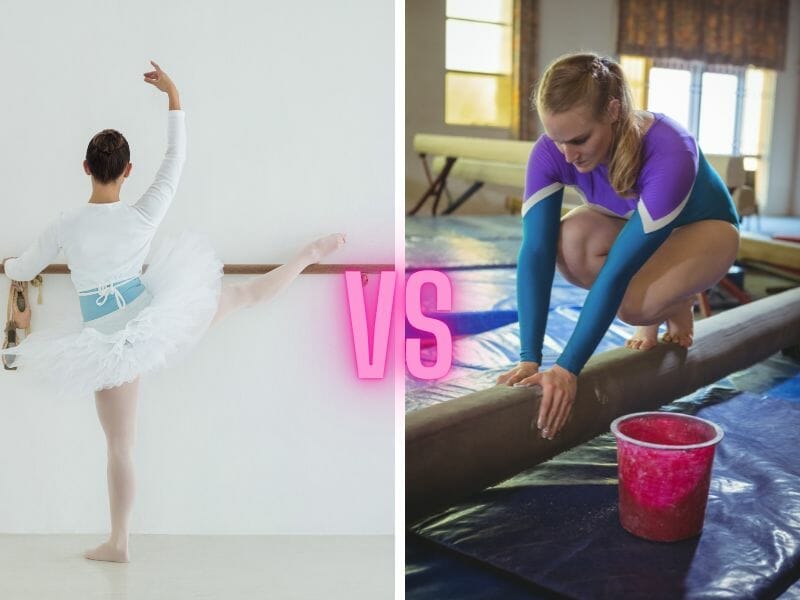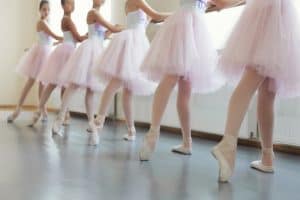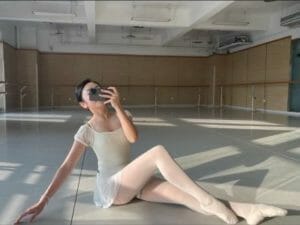Ballet and gymnastics are both common activities for children to take part in. Some even continue the activity into high school and may even go on to do it professionally. This begs the question: is ballet harder than gymnastics?
Ballet and gymnastics have many similarities, but are primarily very different activities. One is not harder than the other.
However, there are many elements of ballet and gymnastics that may be more difficult for a specific individual and other factors that could influence the difficulty of the activity.

Differences Between Ballet and Gymnastics
Both ballet dancers and gymnasts have significant amounts of strength and muscle. However, the muscles required for the two activities are very different.
Ballet requires a lot of lower body strength. Toned leg muscles are very important in order to jump safely, move gracefully, and complete advanced movements successfully. For example, in order to do the classic 32 fouette turns, the dancer must be able to easily complete 32 releves (calf raises) on one foot.
Gymnastics requires some lower body strength as well. However, upper body strength is imperative to being a successful gymnast. Uneven bars, handstands, and vaults all require an immense amount of upper body musculature.
Both ballet and gymnastics require flexibility, as both expect one to be able to do the splits, among other flexibility-dependent movements. However, ballet also requires that the feet be very flexible in order to have a beautifully pointed foot on or off pointe.
Both ballet and gymnastics also require gracefulness and balance. In order to be good at either activity, one needs to make even the most difficult movements appear effortless. This means that great strength and balance is required to appear graceful.
However, gymnastics values stronger, more athletic movements, whereas ballet values lighter, more graceful movements. Both are equally difficult, they just require slightly different skill sets.
Ballet vs Gymnastics Careers
Making a career out of either ballet or gymnastics is very difficult. Not only do you have to have the skill set, you also have to spend a lot of money on training, gear, and events. On top of that, you have to be the right age and, unfortunately, body type in order to even have a shot.
Once you have an opportunity, you then have to rise to the occasion and perform well enough to be able to continue doing it and having more paid opportunities. In the end, most dancers and gymnasts retire early in life and move into other adjacent careers, such as teaching and coaching.
Careers are one of the main differences between ballet and gymnastics and may be the reason for some people being better at one than the other. Gymnastics careers are competition based. Gymnasts must compete at a high level to make a living. This career is extremely short lived and then they must get into coaching in order to continue making money in the sport.
Ballet careers are much different. Ballet careers are focused more on the artistry in combination with the athleticism. Ballet dancers often dance with a company for years, retiring in their 30s or early 40s. After retirement, they may decide to teach or choreograph to continue their ballet career.
Some people have a tendency to be better at artistry and creativity, while others are natural athletes and have a more competitive nature. While both ballet and gymnastics have space for both types of people, they tend to gravitate towards one or the other. This may make one seem significantly more difficult than another to a specific person.
What Makes Ballet and Gymnastics So Difficult?
Ballet and gymnastics are both very difficult to succeed at. They both require years of training, expensive gear, and physically demanding movements. While some people may find one easier than another, they are both still extremely difficult physical activities.
Ballet is hard for a variety of reasons. Firstly, it requires long hours of practice and training both in and out of the studio. Dancers need to keep their bodies in peak condition, both in strength and flexibility.
Ballet also requires females to wear pointe shoes once they are of the right level and age. Pointe shoes can be painful and require a great amount of strength and training to be able to dance well in them.
Gymnastics may not have pointe shoes, but there are plenty of factors that make it difficult. Gymnasts are often performing high in the air, whether on uneven bars, the beam, or flying off the vault. This means that there is much higher risk for injury when landing or falling off.
Gymnastics also involves many different apparatuses, which means that they must be good at all four events, which require different skill sets. This can mean long hours of training in order to be good at every event.
Both ballet and gymnastics require great physical shape. This means that dancers and gymnasts must both work hard outside of the studio or gym to remain in good shape and recover well from training.
Many dancers and gymnasts go to physical therapy on a regular basis in order to keep their bodies in peak condition and prevent injury. This is also helpful in recovering from injuries, whether major or slight. This recovery process is essential to keeping their bodies in good shape for long careers.
How to Choose Between Ballet and Gymnastics
When choosing between ballet and gymnastics, there are many factors to carefully consider. The first is plans for the future. If you are looking to do one of these activities for yourself just as a hobby, ballet is most likely the better option. It has more options for intensity levels and doesn’t require you to do the most threatening movements in order to have fun and succeed to some degree.
However, if you are choosing for your child, there isn’t a clear better option. One way to choose is to look at the person’s skill set. More athletic and competitive individuals might enjoy and thrive in gymnastics more, whereas creative and musical individuals may do better with ballet.
One way to choose is simply to try both. If there isn’t a clear reason to choose one over the other, then why not try them both! You may find that you or your child is naturally better at or enjoys one over the other. This makes the decision much easier and you know you made the right one.
Both ballet and gymnastics are expensive activities. Ballet can seem more expensive upfront because of the large amounts of dancewear and expensive classes, however gymnastics has a lot of hidden fees. For example, gymnastics competitions are very expensive and are a requirement to be successful at the sport.
Things to Remember
Ballet and gymnastics are both extremely difficult, expensive activities that require lots of training to become good at. However, they are both beautiful sports and artforms that bring a lot of joy to those who choose to partake in them.
Choosing between the two options can be difficult, but in the end either option is great exercise, good for the mind, and a fun activity. Both can lead to careers, but both can be difficult to break into.
So is ballet harder than gymnastics? Not necessarily. They are both difficult in their own way. There is no way to define one as being harder than the other. They are different activities that both require advanced skill sets and hours of training. They are both difficult, but worth the hard work in the end.




